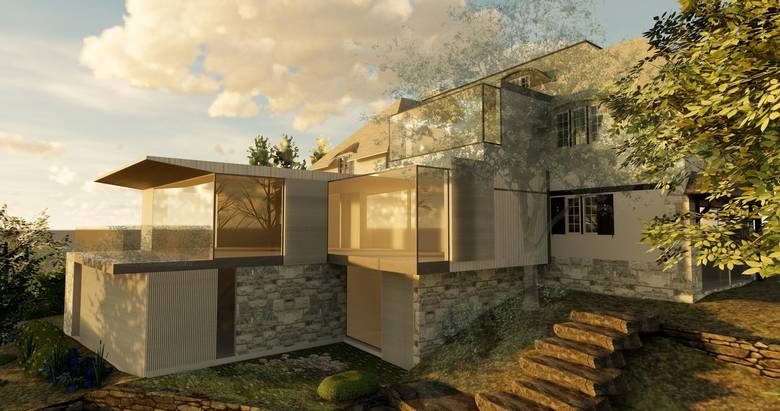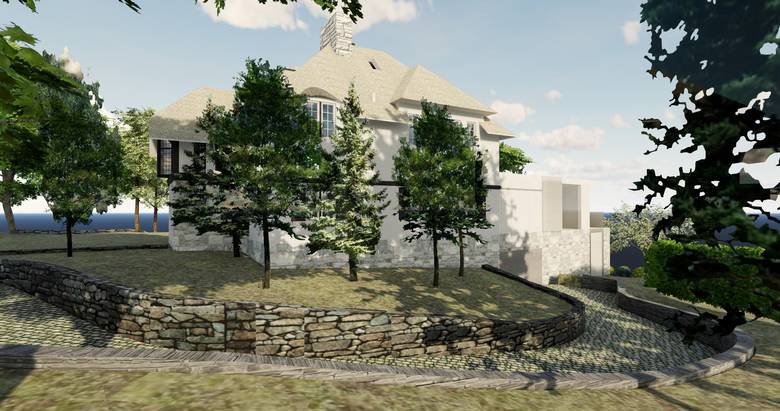

Renderings of the proposed renovation of the Rockcliffe Park home of Shopify co-founder Daniel Weinand.
Even the co-founder of one of North America’s largest tech companies isn’t immune to negative feedback from the neighbours.
Daniel Weinand, a co-founder of Shopify, the Ottawa-based e-commerce company with a $18-billion valuation, got some backlash from the local neighbourhood association in Ottawa’s tony Rockcliffe Park late last year after his plans to add a new addition to his Tudor-Revival home became public.
Mr. Weinand, 38, left Shopify last year to start his own design studio. He also went shopping for a new home.
He was scouting out the neighbourhood – long known as one of Ottawa’s most exclusive neighbourhoods, home to international diplomats, high-net-worth individuals and the Prime Minister’s official residence – when he found the six-bedroom, five-bathroom home that overlooks McKay Lake, tucked away on a quiet street.
Mr. Weinand struck a deal to purchase the property and soon hired Shean Architects Inc. to design an updated rear extension of glass and wood with an expansive view of the lake.
He ran into opposition when the plans were brought forward in a city-planning meeting last November.
Architect Julian Smith, who helped produce a Conservation Heritage Area study on Rockcliffe Park in 1997, told a built-heritage subcommittee that the project posed a significant risk. “I think this is cultural heritage in danger,” Mr. Smith said, according to a report of the meeting in The Ottawa Citizen.
“It seemed to be very sacred to some residents of the neighbourhood,” Mr. Weinand says. “It would be blasphemy to do something to it.”

Weinand initially ran into opposition when his renovation plans were brought forward in a city-planning meeting.
Mr. Weinand’s experience is one small vignette illustrating a larger trend that is bringing change to some of Ottawa’s most exclusive neighbourhoods.
Sales of Ottawa homes worth $1-million or more increased by 38 per cent from 2016 to 2017, and had a five-year increase of 68 per cent, according to the Ottawa Real Estate Board.
And, according to the city of Ottawa, building permit applications in the Rideau-Rockcliffe ward from 2016 to 2017 jumped 55 per cent. In the Glebe, another one of Ottawa’s premier neighbourhoods, building permit applications were up nearly 20 per cent.
More than 13 per cent of all homes sold in Ottawa for more than $1-million in 2017 were sold in Rockcliffe; 7 per cent of the homes worth more than $1-million were sold in the Glebe.
Marilyn Wilson, of Marilyn Wilson Dream Properties Inc., says the increase in million-dollar home sales across Ottawa is primarily due to a trend in upscale construction and renovation. It’s buyers such as Mr. Weinand and others who have made their money in Ottawa’s burgeoning tech industry who are giving the city’s stately neighbourhoods a brash new look.
The market has also gotten a boost from the city’s burgeoning growth: Statistics Canada says the population growth rate in Ottawa last year was the highest in the past 15 years, at 2.2 per cent. The median household income in the city is more than $86,000 – the highest in the province.
The city has also been recognized as one of the best in Canada in terms of livability, which has driven many young workers to come to Ottawa.
“Ottawa has something for everyone,” says Ms. Wilson, who has lived in Rockcliffe Park for the past 33 years and has been an agent for 29. She sold the highest-priced home in the area in 2017 according to OREB, along with the highest-priced home so far in 2018, listed at $1.96-million. “In my opinion, high-end home sales in Ottawa will continue to flourish in 2018.”
Dominique Milne, who has lived in the Glebe for 10 years and is an area specialist for the Engel & Volkers real estate brokerage, says that neighbourhood is as “hot as ever.” She says properties are receiving multiple offers and are usually selling in under a week, invoking agents to compare the scene to Toronto.
“There’s not a lot of inventory and everybody wants to be here,” she says.
Ms. Milne says the Glebe has a mix of new buyers, including doctors and lawyers but also younger people who are working for new tech companies (Mr. Weinand currently lives in the Glebe) – who will see an older-style home and will put a new addition on, or update a kitchen to have modern-day conveniences.
“They’ll do something that will marry both the classic and the modern,” she says. “As much as we have a lot of people who have been in their homes for 40 years, there’s an influx of new blood, younger blood as well.”
Buying in the Glebe or Rockcliffe remains aspirational for many young buyers, but according to Derek Hooper, a broker with ReMax Hallmark Realty Group, he’s seeing a large portion of that age bracket rent for longer – in order to stay in the walkable neighbourhoods – and buy at 35.
He’s also seeing young professionals who’ve established themselves in another major city, such as Toronto, move to Ottawa.
“They’re seeing value to move back here because they can actually afford to buy a house and build and grow here,” says Mr. Hooper, who admits Ottawa has been underpriced for a while and is now catching up.
While the influx of new buyers may mean changes for the look-and-feel of a classic neighbourhood such as the Glebe, Mr. Hooper says that’s a positive. Although he doesn’t like every infill that’s put in, he says it’s good for the neighbourhood to see ongoing building take place.
“It’s bringing new life to maybe under-utilized properties, and I think it’s just a natural thing that you’ll see. It’s a good sign for a neighbourhood,” Mr. Hooper says. “It’s easy to protest it, but you should be happy your neighbourhood is attracting that kind of investment.”
Susan Peterson d’Aquino, a board member of the Rockcliffe Park Residents Association, says having young people come in to the neighbourhood is a good thing and the mix of how homes look matter less, as long as the heritage character of the neighbourhood – and its park-like setting – are maintained.
“There are all kinds of designs and periods in Rockcliffe … it’s a continuing phenomenon. I live in a Modernist house built in 1959, and at the time it was probably hard on the eyes on some of the neighbours,” she says with a laugh. “But now it’s a much-loved house in Rockcliffe. That’s just the reality. There will be continual change.”
© Copyright (c) The Globe and Mail